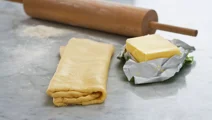
Pita bread

Instructions
Tips
When making pita bread, the water must have the right temperature to dissolve the yeast. Yeast makes the pitas rise, but if the water is too hot, it will kill the yeast, and the bread will not rise. Likewise, if the water is too cold, the yeast will not activate, resulting in flat pita bread. Ideally, the water should have a temperature somewhere between 32-38°C.
Tips
Be sure to add the last of the flour little by little. It may be tempting to add it all at once, especially if the dough feels sticky, but you need moisture in the dough to make the Greek bread puff in the oven. So, if you add too much flour, you will end up with dry dough. It is important to flatten the bread as evenly as possible; otherwise, it might puff more in some areas while staying flat in others.
Questions about pita bread
Making pita bread at home is straightforward and effortless with our easy pita bread recipe and a few basic but well-picked ingredients. Read on and learn how to make soft, fluffy, golden-brown pitas that you can stuff with delicious and tasty fillings.
Ingredients
Milk | 150 ml |
|---|---|
Water | 150 ml |
Yeast | 25 g |
Sugar | ½ tsp |
Coarse salt | ½ tsp |
(approx. 1 dl) durum flour | 60 g |
(approx. 6¼ dl) pizza flour | 375 g |
Make your own soft pita bread
Few can resist the warm smell of delicious, fluffy, and puffy pita bread. Our recipe is simple and only requires a few ingredients, most of which you already have at home so you can easily enjoy this fresh, warm, perfectly delicious homemade creation. The soft bread has an empty round pocket that is just waiting for you to stuff it with your favourite pita bread fillings and dressings. You can even rip the bread into bite-sized pieces and dip it in soups and stews. It is the perfect bread to serve as a main dish or a companion to countless other delicious meals.
In need of inspiration for your pita bread fillings? Take a look at our recipe for falafel with chickpeas, crispy on the outside and soft on the inside, or try your hand at our butternut squash salad, Greek salad, or maybe hummus for both flavour and delicious dressing.
The traditional Greek bread
This traditional puffy Greek bread is a staple in countless Greek dishes. Though Greece is said to be home to over 70 different types of bread, pita bread is by far one of the most popular and world-renowned choices. These savoury and scrumptious bread are baked at high temperatures, turning the water in the dough into steam, thus allowing the pita to expand and create a magical little pocket that sets this bread apart from so many other types of flatbreads.
Delicious fillings for pita bread
These pita bread pockets are perfect for transporting delicious fillings for a quick lunch on the go. There are no limitations when it comes to picking a filling for your bread. Make it Greek style with chicken gyro, creamy tzatziki, and lettuce, all wrapped in a warm and soft pita. A perfect balance of herbs and aromas that will blow you away. For a filling with extra veggie crunch, make a lemon-marinated bean filling and toss beans, onions, tomatoes, celery, and herbs. Mix lemon juice and zest with garlic, olive oil, salt, and honey and pour over the bean salad. Combine the dressing and salad and stuff the honey-lemon flavoured mix into your pita.
You can even make a dessert version that the kids will absolutely adore. Simply put some hazelnut spread and maybe even whipped cream or a few sliced berries inside.
Make it your own
Elevate your pita bread with seasonings for extra flavour. Knead and shape the dough per the instructions in the recipe and let it rise while preparing the seasoning for the bread. Mix olive oil, smoked paprika, garlic powder, and Italian seasoning, which combines several different dried herbs such as basil, rosemary, and oregano. Spread the mixture all away to the edges of the pitas right before placing the bread in the oven. The combination of spices and herbs makes for a refreshing and aromatic experience that is hard to resist and undoubtedly demands seconds.

&format=webp)




&format=webp)



